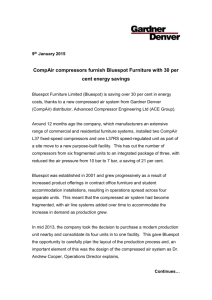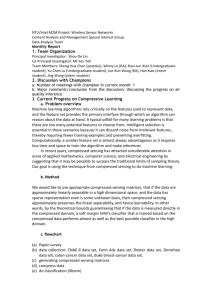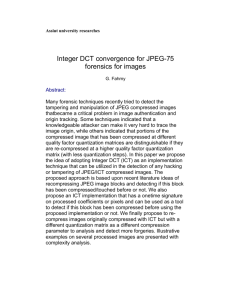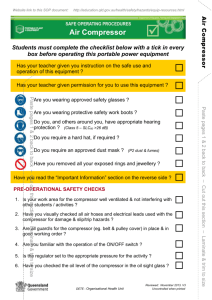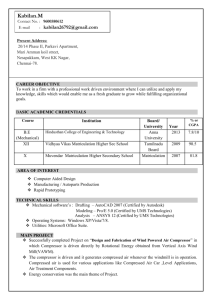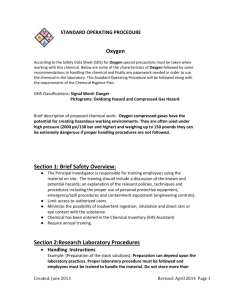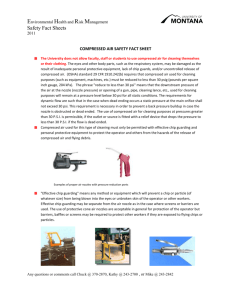APPENDIX P - Compressed Air Systems
advertisement
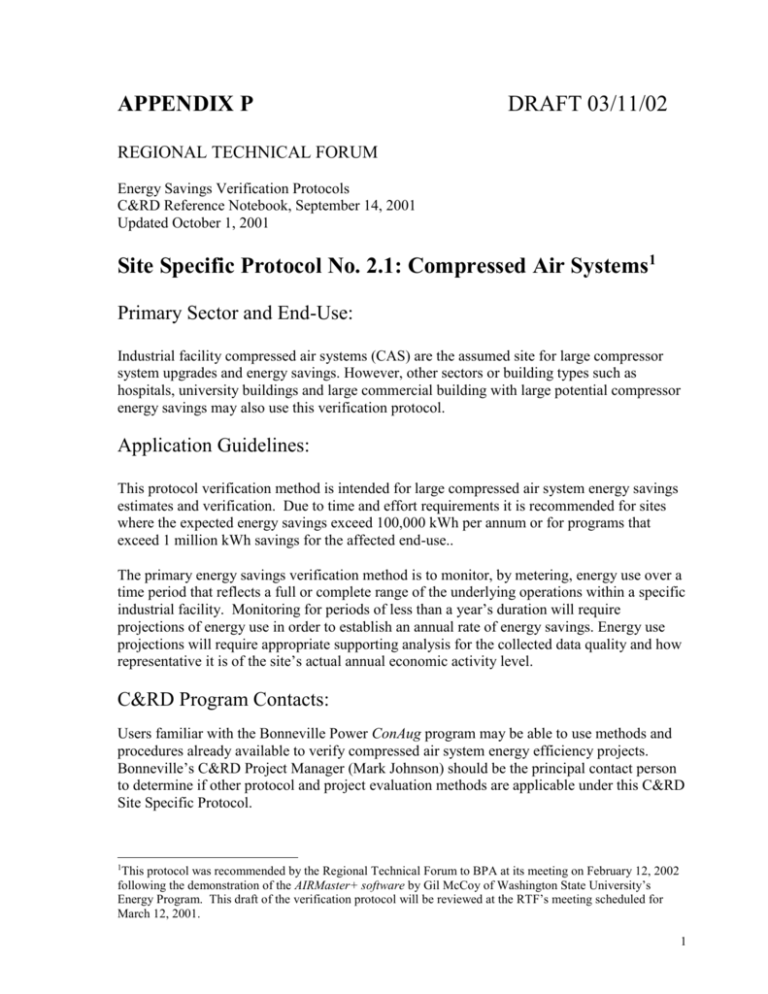
APPENDIX P DRAFT 03/11/02 REGIONAL TECHNICAL FORUM Energy Savings Verification Protocols C&RD Reference Notebook, September 14, 2001 Updated October 1, 2001 Site Specific Protocol No. 2.1: Compressed Air Systems1 Primary Sector and End-Use: Industrial facility compressed air systems (CAS) are the assumed site for large compressor system upgrades and energy savings. However, other sectors or building types such as hospitals, university buildings and large commercial building with large potential compressor energy savings may also use this verification protocol. Application Guidelines: This protocol verification method is intended for large compressed air system energy savings estimates and verification. Due to time and effort requirements it is recommended for sites where the expected energy savings exceed 100,000 kWh per annum or for programs that exceed 1 million kWh savings for the affected end-use.. The primary energy savings verification method is to monitor, by metering, energy use over a time period that reflects a full or complete range of the underlying operations within a specific industrial facility. Monitoring for periods of less than a year’s duration will require projections of energy use in order to establish an annual rate of energy savings. Energy use projections will require appropriate supporting analysis for the collected data quality and how representative it is of the site’s actual annual economic activity level. C&RD Program Contacts: Users familiar with the Bonneville Power ConAug program may be able to use methods and procedures already available to verify compressed air system energy efficiency projects. Bonneville’s C&RD Project Manager (Mark Johnson) should be the principal contact person to determine if other protocol and project evaluation methods are applicable under this C&RD Site Specific Protocol. 1 This protocol was recommended by the Regional Technical Forum to BPA at its meeting on February 12, 2002 following the demonstration of the AIRMaster+ software by Gil McCoy of Washington State University’s Energy Program. This draft of the verification protocol will be reviewed at the RTF’s meeting scheduled for March 12, 2001. 1 An Acceptable CAS Energy Savings Estimate: Compressed Air System Description: An air compressor system consists of one or more electric motors, compressor air-end/packages, filters and/or dryers, pressurized air reservoirs, distribution piping and valves, and point-of-use tools. Opportunities exist to improve equipment efficiency through equipment replacement, improvements in equipment operation and scheduling and through manufacturer recommended maintenance schedules and operating guidelines. Efficient plant air system design could reduce electricity consumption even further. Compressed air systems are complex and are generally unique to each facility’s end-use mix of equipment and production practices. As with all C&RD saving protocols, a pre-installation set of measurements for energy use (kWh) is required and a post-installation set of measurements is also required to determine the change in energy use as a result of the energy saving measures implemented. Important Elements of a Savings Verification Plan: A savings verification plan should be prepared for the compressed air site. The following seven elements are important parts of a measurement and verification plan for a CAS energy efficiency improvement project. (See also the section titled AIRMaster+ Features.) 1) Detailed Compressed Air System Inventory: A complete inventory of the various components of the compressed air system should be done. The CAS equipment and components and their energy use features should be specified in detail. This step defines the site specific compressed air system. 2) Trained Personnel: the Company submitting a verification of savings report should identify the personnel involved in the C&RD project. Training through the USDOE Compressed Air Challenge program is highly recommended. Individuals completing the certification process are certified as Compressed Air System Evaluation Specialists. 3) A Metering Plan: This is a key part of the overall verification plan and specifies how the pre-installation energy use base case and the post-installation energy use are to be measured.2 Issues related to accuracy in terms of the data as well as its extension to full years estimates should be included in the analysis. 4) Pre-installation Measurement Plan and Data: This part of the verification plan defines the pre-installation or base case and specifies how component and system measures are to be done and what tools are to be used including the role of the AIRMaster+ in determining system base case measures and results. The results should cover at least two week’s worth of timed meter measures (e.g., 10 min per 2 In addition to the metered equipment to be used and the strategy for collecting energy use data, the Metering Plan should include data and analysis of how representative the metered period is relative to a “normal” activity period. This analysis should comment on changes in product or production process equipment that typically does significantly impact the compressed air use in the facility. 2 hour) or for a period that covers the full range of underlying economic activity for the site. 5) Post-installation Measurements and Evaluation: This part of the verification plan is assumed to use the AIRMaster+ software or its equivalent to determine the amount of eligible kWh savings on an annual basis. 6) Develop a Measure Life Analysis: This refers to the assumed life of changes in the compresses air system that would be considered either energy conservation measures or system changes that result in measurable energy savings. This part of the verification methodology is intended to provide supporting analysis of the life, in years, of energy conservation measures or system changes included in the CAS improvement project. The report should include justification for major long-life measures such as the installation of a sequence controller or a load-unload controller. 7) Load Shape of Savings: Industrial CAS energy and power demand savings are anticipated to approximate usage shapes, which are assumed to be relatively flat for the industrial sector. The AIRMaster+ may provide enough day-type data to develop a load shape for the facility. It should be noted that all of the energy savings from a site improvement project may not qualify for C&RD credits. Only incremental energy savings measures are eligible for credits. This, in particular, applies to certain measures such as leak maintenance that are regarded as a standard maintenance activity, not an incremental energy savings measure. There may be other similar O&M installation items that contribute to energy savings but are not regarded as eligible for C&RD credits because they are not regarded as incremental savings. Thus, measurement tools that can differentiate among individual energy measure’s contribution to savings will be necessary in order to separate eligible and ineligible measures and impacts. Fortunately, the AIRMaster+ tool can perform these functions and is included here as a recommended tool for CAS energy savings verification. Other similar tools that can perform the same or equivalent functions as the AIRMaster+ tool can be used with prior approval of the C&RD program. Possible Program Development Aspects: Eligible utilities may want to develop and market a compressed air system (CAS) energy efficiency upgrade project using AIRMaster+ for industrial sector customers. The individual projects can be grouped into a CAS Program with the protocol steps covering multiple projects and compressed air systems. 3 Key Measurement Issues: There are several important measurement issues that need to be addressed when estimating the energy savings from compressed air system improvements. These include: a) the nature of the system upgrade, b) the energy saving measure life, and c) the identification of the appropriate or default load shape for calculating savings for the bulk power system and C&RD credits. Changes in compressed air systems can be of several types. For upgrades and improvements, a retrofit or replacement project can be done. For new plant construction, including plant expansions, decisions may involve the choices among a range of energy efficient equipment. In addition, a site-specific improvement could simply employ improved technical management of the system, the elimination of inappropriate end uses and, perhaps, simply the reduction of system air pressure. Compressed air system measure life analysis should be part of the project including the discussion of measure life estimation. One approach here would be to poll known CAS experts on an appropriate measure life for the energy efficiency measures most often recommended as compressed air system improvements. See Addendum B for an initial outline of how various system improvement measures can be identified and grouped according to measure life. To reduce outcome uncertainty and to lower investment cost risk, individual projects could include studies of post-installation results and compare actual results versus projected results, including projections based on the AIRMaster+ model, and identify the factors that led to large variances in projected results. For retrofit projects, data monitoring should take place over at least a two-week period prior to installation of the proposed energy conservation measures or over a period that covers the full range of process operations. Comparable monitoring should be done after the energy conservation measures have been installed and should also reflect a full range of process operations. For complete CAS replacement projects, the energy savings estimate should be normalized based on the actual level of process production during the time period monitored and adjusted for changes in the energy per unit of production and the changes in production volume during the post-installation period. Changes in energy per unit of production and projected annual production volume would be used to calculate annual energy savings. Energy use could be based on monthly utility bills and production changes could be based on value of shipments plus new finished goods inventory data. In a new construction situation where past process production volume and past energy consumption data are not available, the determination of energy use per unit of production will have to be based on some form of comparable site such as a similar process in-house or in-company at another facility. In some cases energy per unit of total facility production may need to be used to estimate annual energy savings. It is 4 possible that the company applying for energy savings credits can document different levels of energy efficiency based on different equipment used or different configurations of the system equipment. Credits may be applicable for system upgrades analogous to the Energy Star upgrade credits for standard and high efficiency motors, for example. Recommended Tools:3 AIRMaster+ or an equivalent CAS analysis tool is recommended. Further, it is recommended that industry or process expert assistance be employed in the application and interpretation of the tool when estimating annual energy savings. The identification and use of appropriate power and energy metering devices to assist in the data gathering and analysis tasks is also highly recommended. The AIRMaster+ software is designed to assess the energy and cost savings from energy efficiency measures that are often recommended to improve the energy performance of compressed air systems. These include: 1. 2. 3. 4. 5. 6. 7. 8. Improve end use efficiency (eliminate inappropriate compressed air uses) Use unloading controls Reduce system pressure Adjust cascading set points Add primary receiver volume Identify and repair system air leaks (periodically) Sequence or stage multiple compressors (use automatic sequencer) Reduce run time (turn compressors off or use an automatic shutdown timer). AIRMaster+ can be used to determine the kWh and kW savings for each measure with interactive effects taken into account. Savings from a variety of retrofit actions can be analyzed, such as installing dew point demand controls on dryers; installing zero-loss drains on receiver tanks, or installing larger diameter distribution piping to reduce system pressure losses. The software is also capable of analyzing complex measures such as installing a dedicated compressor to meet a high-pressure load, installing a small compressor to meet light evening loads, or incorporating an energy-efficient adjustable speed drive (ASD) trim compressor in the engine room. The software can model any number of compressors, compressor types, or control configurations. AIRMaster+ Features: 3 See Addendum A for a brief description of the AIRMaster+ tool. 5 1. Compressor performance and system airflow requirements are determined from onsite electric power measurements. Data logger results are used to determine hourly electric loads for any number of "day types". Generally, it is recommended that data loggers track system power use over a one-to two-week period. One hour of highresolution data is also recommended---with readings taken at each compressor on 10 to 20-second intervals. 2. Airflow performance can be directly measured with appropriate meters and entered directly into the AirMaster+ 'Air Profiles' module. Alternatively, AIRMaster+ can calculate system air requirements. The calculated airflows are based upon the availability of hourly average kW, or hourly average volt and amperage readings. 3. Leak detection is normally done with an ultrasonic leak detector used during downtime such as a weekend no-shift period, when production and noise levels are minimal. Leak detection and elimination is recognized as an industry Best Practice that should be undertaken part of a normal preventive maintenance program. Since leak identification and repair is a constant and recurring activity with a short measure life, it should not be eligible for C&RD incentives. 4. Pre-installation Measurement: Power meter and data logger information would be entered into AirMaster+ to "baseline" the compressed air system annual energy use and operating cost. This would include overall plant production normalization of the system load profile. This serves as the “before” energy use baseline. 5. Post-installation Measurement: After installation of the cost-effective energy efficiency measures identified in the AirMaster+ assessment, data loggers are again used to gather at least one week worth of hourly average airflow or power readings for each compressor. This information is entered into AirMaster+ to determine postinstallation facility annual compressed air system energy use. Compressed air measure energy savings are "verified" by taking the difference between the pre and post-installation estimates of annual energy use. 6 Addendum A: Description of AIRMaster+ Main Menu The AIRMaster+ Main Menu, on the opening screen of the program, provides access to each of the program’s modules. You can access each module through the menu bar (across the top of the window) or the module buttons. The status bar at the bottom of the Main Menu displays the selected company name, company database location, AIRMaster+ version number, current date, and time. 7 AIRMaster+ Modules: 1) Company: Enter or view company information and company databases. 2) Utility: Enter or view utility company data or rate schedules. 3) Facility: Enter or view facility (site) data, facility utility rate assignment, and a summary of the air compressors on site for the selected company. Each facility may contain one or more compressed air systems. 4) System: Enter or view system-level information, including design and performance parameters, automatic sequencer control pressure set points, day-types, and end uses. Each system consists of one or more air compressors. 5) Compressor: Enter or view in-plant air compressor information, including detailed specifications, or search for inventory air compressors that meet specified criteria. 6) Profile: Enter hourly average airflow or power information and operating schedules to calculate system baseline airflow requirements and associated energy and demand costs for the selected system and day type. 7) Efficiency Measures: Select efficiency measure(s), and apply them to a compressed air system. Proposed energy, airflow, and dollar savings may be viewed for each efficiency measure. 8) Maintenance: Enter, sort, and view maintenance records. Records contain maintenance activities, schedules, and costs. 9) Catalog: View information for generic air compressors of various ratings, or edit userentered compressors. You can build your catalog listings by adding information to represent your inventory air compressors. 10) Life Cycle: Enter life cycle analysis setup information, and view financial calculations for a project or equipment, such as after-tax return-on-investment, net present value, and benefit-to-cost ratio. 11) Print Data Input Forms: Select a data input form, edit the form title, then preview and print the data input form. Data input forms allow you to record the information you must gather to input into AIRMaster+. 8 Addendum B: Measure Life Analysis Changes in compressed air system components can be of three types in terms of the typical life of an efficiency measure installed. The three categories involve labor-time for O&M activities, system management analysis and controls and major capital equipment retrofit improvements to compressed air systems. The first categories of improvements involve labor time used for leak detection and are likely to be the principal O&M activity. In addition, normal maintenance on the compressor itself could include air filter changes and equipment lubrication as appropriate. The second category involves system management the main activity involves, typically, improvements in run-time and system pressure and may involve the installation of system loading and unloading controls with automation and storage capacity A third category of activity is compressed air equipment purchase and use. This requires matching compressor capacity or size with the facility loads or the use of ASD’s for rotary screw compressors, if indicated by the AIRMaster+ analysis. Taken together these three kinds of system improvement categories can be used as a framework for gathering expert opinion on appropriate assumptions to be used for the measure life of CA system improvements. These the measure life of these components can be summarized in a three-part measure life table, an initial version of which appears as TABLE 1. The table summarizes the key efficiency measures that are often included in a compressed air improvement strategy. The effects of these retrofit changes can be modeled with the AIRMaster+ software. Measure life estimates can be developed by requesting expert opinion for the full range of system improvement components from TABLE 1. 9 TABLE 1. Measure Life of Compressed Air System Components System Improvements: O&M (Labor Intensive) System Management Standard Maintenance Repair Leaks, change filters, etc. Every few months Enforce schedule and make results known Several months+ Load/Unload Controls ASD’s for rotary screw Matching compressor capacity and load/install designated compressor Reduce System Pressure CA Equipment Selection and Controls Several years (Ultrasonic detector) Several years Several years Several years Several months+ Reduce Run Time Several months+ Sequence or Staging of Multiple Compressors /Install Automatic Sequencer Eliminate Inappropriate Uses/Install air knives, engineered nozzles, blowers, electric mixers Desiccant Dryer Controls/Dew Point Demand, Heat Recovery Install Cycling Refrigerate Dryers Air Distribution System Improvements/Increase pipe diameter, install crossconnects Several months+ Several years Several years Several years Several years Several years ________________________________________ a:\compressed air verification protocola.doc 10

